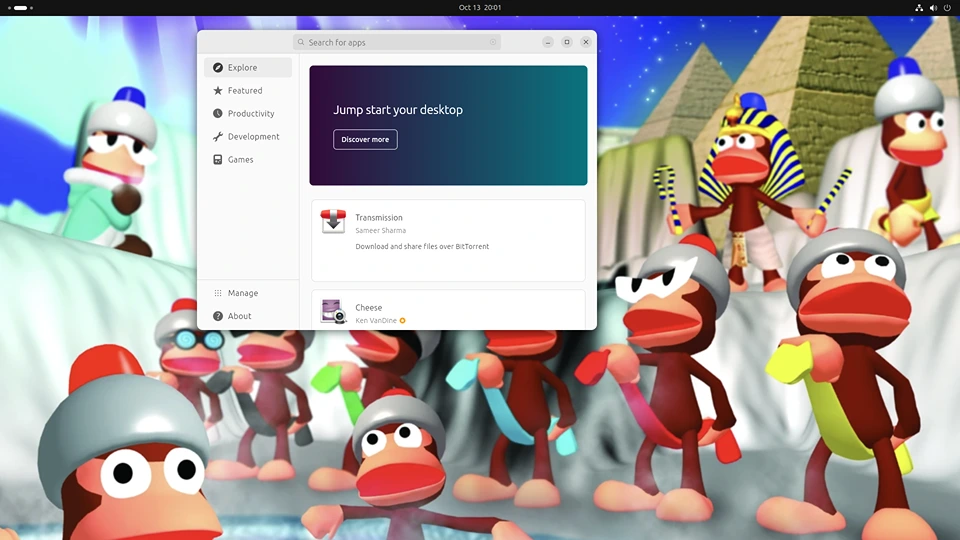
Friends, Ubuntu 23.10 is out ! The Mantic Minotaur is ready to make your desktop rage like a bull in the arena (Wow !) Now what does it really change from the Lunar Lobster (23.04) ?
A new snap store
Now, maybe you don’t like snaps for various legitimate reasons, but the fact is, the new snap store is snapping fast (Wow again !) and makes them suddenly much more enjoyable to install and play around with. Yes, in previous versions you could always install snaps with the terminal (sudo snap install …) but let’s tell the truth : having a properly working GUI (graphical user interface) makes the life of normal people much easier. And let’s add a sound argument to this case : having a functional GUI allows you to browse snaps and packages and see what’s available in a much more convenient way, and then if you’re a purist you can still use the command line to install them.
Plus, I find that the new store is less snap-centric, as .deb packages are clearly indicated on a separate line in the search results.

Way of the empty install.
The now default option to install Ubuntu is “Minimal install” which means that you really only get the bare essentials installed by default. This point was controversial among Linux enthusiasts but my opinion is that it makes perfect sense coupled with the new software manager, provided you have access to fast and steady Internet. (Before, with the previous laggy software store , it was theoretically possible but not so enjoyable)

I think this is a step further into the evolution of operating systems, towards a more and more containerized approach, meaning the system is made of separate parts that each have their own separate update cycles, parts that don’t or only minimally interfere with other parts. Imagine a Lego brick construction, where each brick can be independently updated without modifying the rest of the structure (We’re talking smart bricks, friends). More, each brick possesses in itself everything it needs to function, which means if you put a fire producing brick in another construction, it will still produce fire there (Fire bricks don’t exist in real life) without needing to alter the rest of this construction.
Now… what does this have to do with minimal install and fast software installation ?
With better software management and less preinstalled applications, we are getting closer to something that looks like Ubuntu Core, today mainly used for IoT (Internet of things, e.g. : smart house devices, WiFi advertisement boards, …). It is getting easier to optimize a computer for a specific task while keeping options open to change it in the future. Let’s say you want to turn your desktop into an image editing device, you can install only the required packages via snap (or flatpak if you prefer) and save on RAM and disk space by not having other software bundled from installation. Want to change later ? Containerized packages do not modify your core system (adding libraries for example) so by uninstalling your snaps (or flatpaks) packages your computer is back to his clean original state and you can again use packages to turn it into something else.
With .debs, libraries are added to the operating system and cleaning up after uninstalling can get gruesome if you have a lot of packages and repositories to remove from accumulated time.
Note that still, the .deb vs snap debate remains a heated one, and you might have a totally different opinion. For full disclosure : snaps are also criticized for being slower at start and heavier (because they contain all their needed dependencies) than .debs, and for being closed-source and controlled by Canonical, the company behind Ubuntu.
Gnome 45
Gnome 45 is also out ! I must admit that I didn’t pay so much attention to the changes, except for the workspace indicators which is simple yet functional, by default I turn of most Ubuntu Gnome extensions, so the new tiling features I am not using really. (see here for how-to). Overall it is still in good, fast and efficient Gnome 4x, perhaps more minimalist than before.
The Linux kernel was also updated, sadly it did not make my cheap new Bluetooth dongle supported, I guess I will have to get another one !
Xubuntu 23.10

Now the time has come to try Xubuntu 23.10 too, I’ve installed it on my other machine from 2010 to make a vector graphics creation computer (Before you jump trough the roof, it has 8GB RAM and can handle them). Maybe I will write more about it later… Until then, let’s enjoy one of the most intriguing features of the 23.10 release, this wallpaper :

Bonus: how to disable Ubuntu Gnome extensions.
To disable the very nice but not necessarily wanted Ubuntu extensions to Gnome, we will use “Extensions”, an app provided by Gnome themselves to extend the Gnome desktop.
To install it, open a terminal (Ctrl+Alt+T) and type (and press Enter) :
sudo apt update
sudo apt install gnome-extensions-appTo open the extensions manager use :
gnome-extensions-appIn a graphic way, go to the software center and search for “Gnome Extensions”, the one we use is “Extensions” but “Extension Manager” is equivalent in its function, while different in its nature. Install and open.

To get the classic Gnome desktop, just turn off the built-in extensions, i.e. : Desktop Icons, Ubuntu AppIndicators, Ubuntu Dock and Ubuntu Tiling Assistant. Be warned : plain Gnome is really minimalist ! But once you get used to it it’s actually very fun to use.
I keep GSConnect that I installed because it adds a very useful app to connect your phone to your computer… Maybe I should write a tutorial…
Enough for today.



